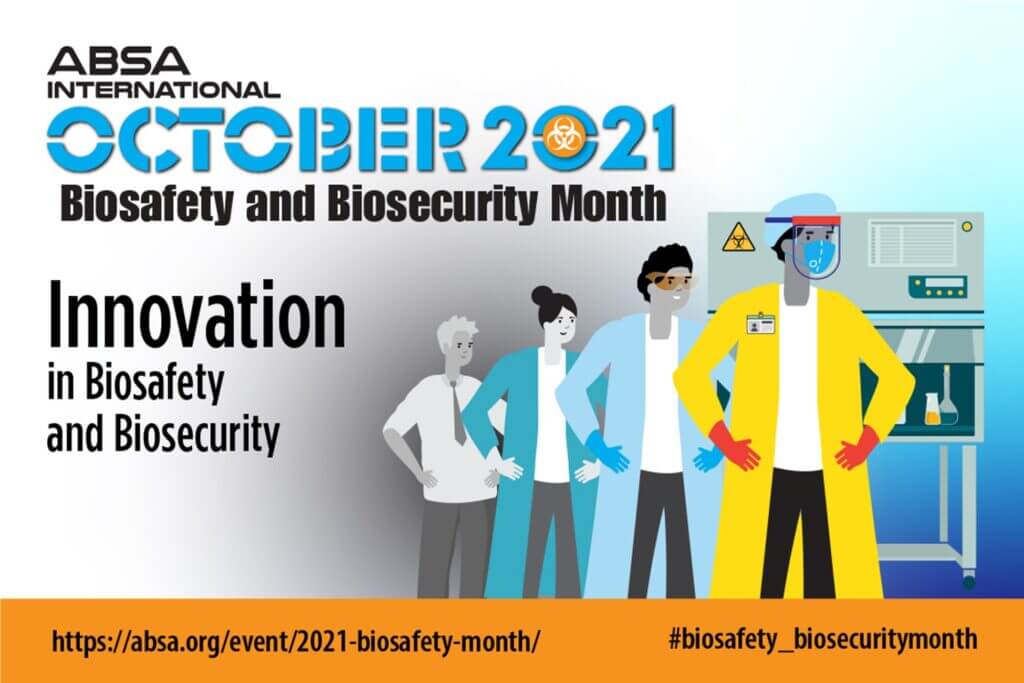
Celebrating Biosafety Month (Or How the Pandemic Brought Biosafety to Everyone’s Front Door)
10.07.21
By Rachel Gamble, DrPH, RBP, CBSP, Associate Director of Biosafety and Biosecurity
October is a wondrous time of the year, and it’s at the top of any biosafety professional’s list of favorite months for a good reason. Why? you may ask. It’s Biosafety and Biosecurity Month! Who needs Halloween when you can chat disinfectants and room decontamination with your fellow compadres?
This is the time of the year that biosafety aficionados sit around our fire pits (or swimming pools, because it’s still hot in Texas) sipping our favorite fall beverage (c’mon, we all know it’s pumpkin spice-flavored) and contemplating the greater biosafety universe and the changes we’ve seen from the “good ole days” to now. One can’t help but notice how simple biosafety practices have made big impacts in our daily routines. Let’s face it: when we all anxiously waited for the big, sparkly ball to make its much-anticipated descent in Times Square to kick off 2020, none of us had any inkling of the wild and crazy ride we were about to strap ourselves into and that we’d still be riding well into 2021.
Let’s take a stroll down memory lane, shall we? Picture this: You’re at the grocery store in May 2020. What do you want? HANDSOAP! What else do you want? CLOROX WIPES! Anything else? TOILET PAPER! I’m not 100% sure how things were where you lived, but I couldn’t find any of those seemingly mundane items to save my life. I remember thinking, “Did no one wash their hands, disinfect stuff, or use toilet paper before this?!” Hand soap and Clorox wipes became a currency of their own: “I’ll trade you five bottles of my finest ‘vino’ for one bottle of soap.” Overnight, the simple act of washing your hands became a number one priority for everyone everywhere—and rightfully so. Our biosafety folks had been pushing—I mean, training—on the importance of handwashing since the beginning of biosafety times, and now it had caught on like a fire in a cotton field in western Oklahoma. Huzzah!
Now, what about those Clorox wipes? Being an ex-labbie with an ingrained need to clean and disinfect, it struck me that perhaps not everyone cleans as enthusiastically as I might. While I have always treated my kitchen like a makeshift BSL-2 lab and was already mindful of touchpoints, now everyone else was thinking like that, too! Searching for Clorox wipes was akin to searching for a golden ticket to visit Willy Wonka’s Chocolate Factory. Finding them elicited much rejoicing (and maybe a touchdown dance) as you spiked them into your shopping cart. Again, the wild and crazy biokids had been preaching the importance of surface disinfection and touchpoints to our adoring research personnel, but now everyone was on board to “clean it like you mean it.” Being cognizant of surface decontamination and being aware of what you’re touching are easy biosafety hacks that are small investments in your health. They add up and pay dividends over time, especially if you continue doing them after the pandemic is over.
Now: on to the fashion! Red, blue, green, houndstooth, neon yellow with tiny dinosaurs…any fabric and pattern your mind can imagine has made its way onto a sewing machine and been turned into a fashionable face mask to match your favorite outfit. In addition to the benefit of face masks (a.k.a. personal protective equipment or PPE), individuals became more aware of cough and sneeze etiquette. While there will always be the occasional projectile-sneeze offender, masks in conjunction with improved self-awareness have really helped cut down on the walk-through germ clouds that were lurking behind every turn of the aisles in your local supermarket. However, while face masks have become a regular accessory, it’s important to remember that just like laboratory personnel using PPE, sometimes it’s time to change things up. And by things, I mean your mask. I know the yellow dinosaur mask may be your favorite, but like any good outfit, you should change it at least daily.
These are just a few common biosafety practices that have wriggled their way into the daily lives of everyone, and while I will never go as far as to say I’m glad the pandemic happened, people did adopt a lot of easy and simple practices that will serve them and others well for a lifetime. Despite the wild ride we’ve been on (and are still on) there’s always a silver lining if you’re willing to look for it. My hope is that everyone will continue to maintain and exercise these simple biosafety practices in their daily lives for years to come, not just when a pandemic compels them to. Now go enjoy your pumpkin spice, extra foam, two pumps of sugar-free cinnamon dolce syrup, extra whipped cream, caramel drizzle with festive sprinkles latte, and raise your beverage to cheer for Biosafety and Biosecurity Month!
